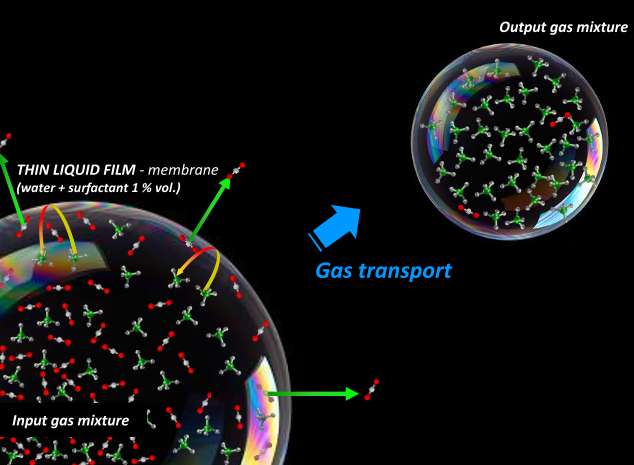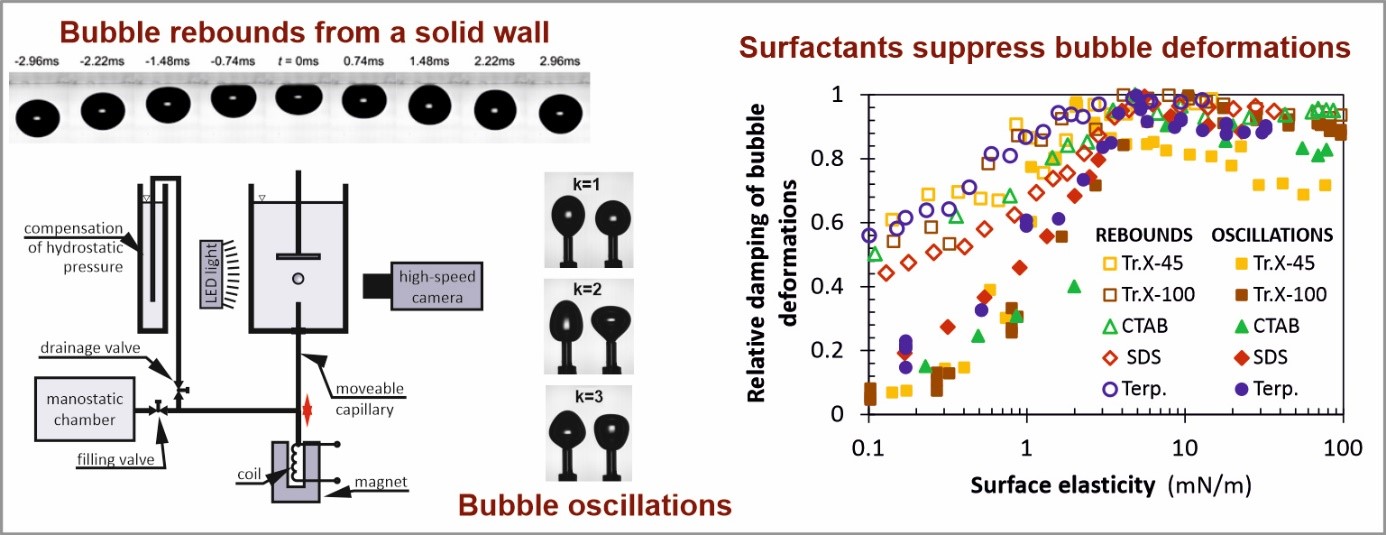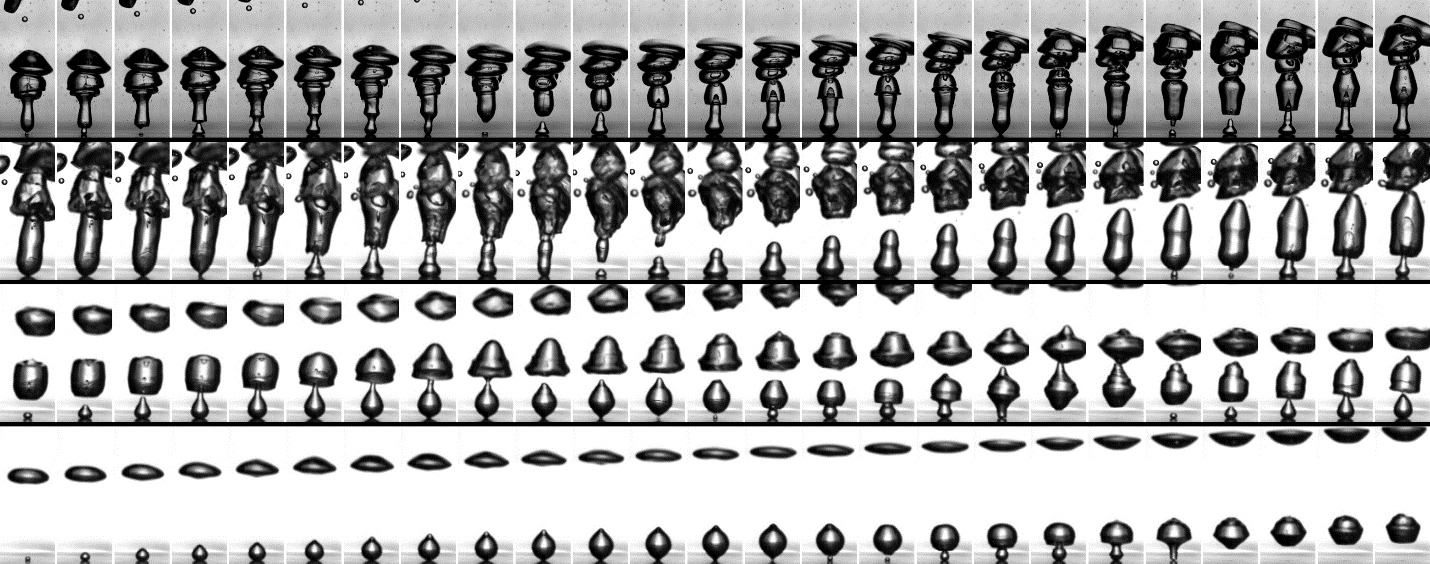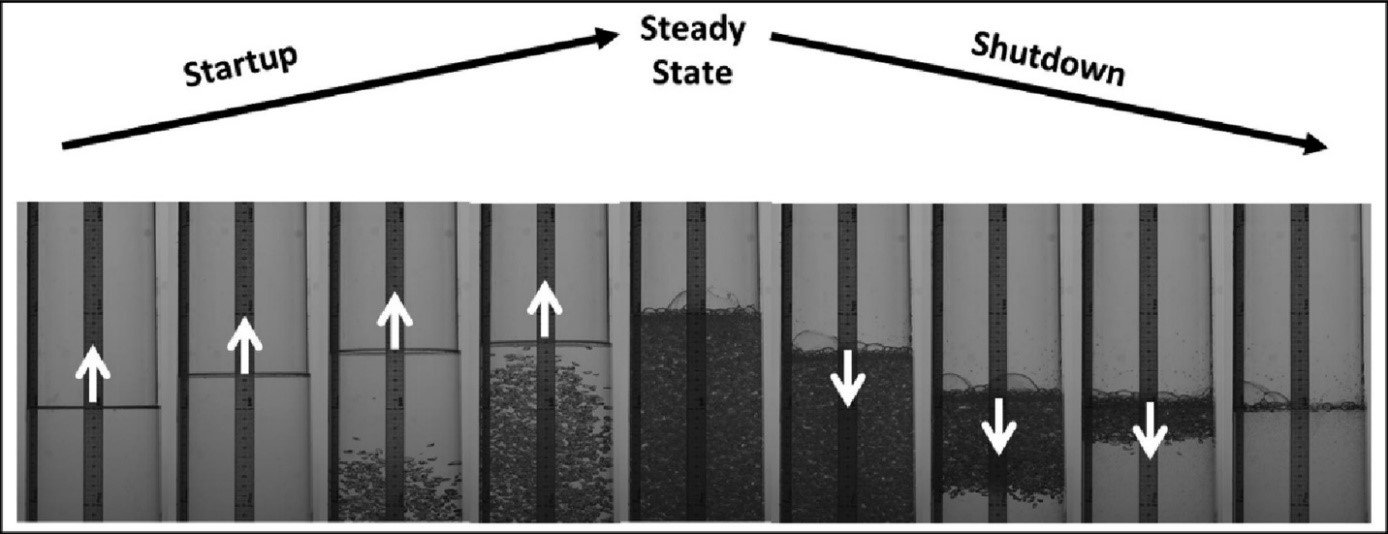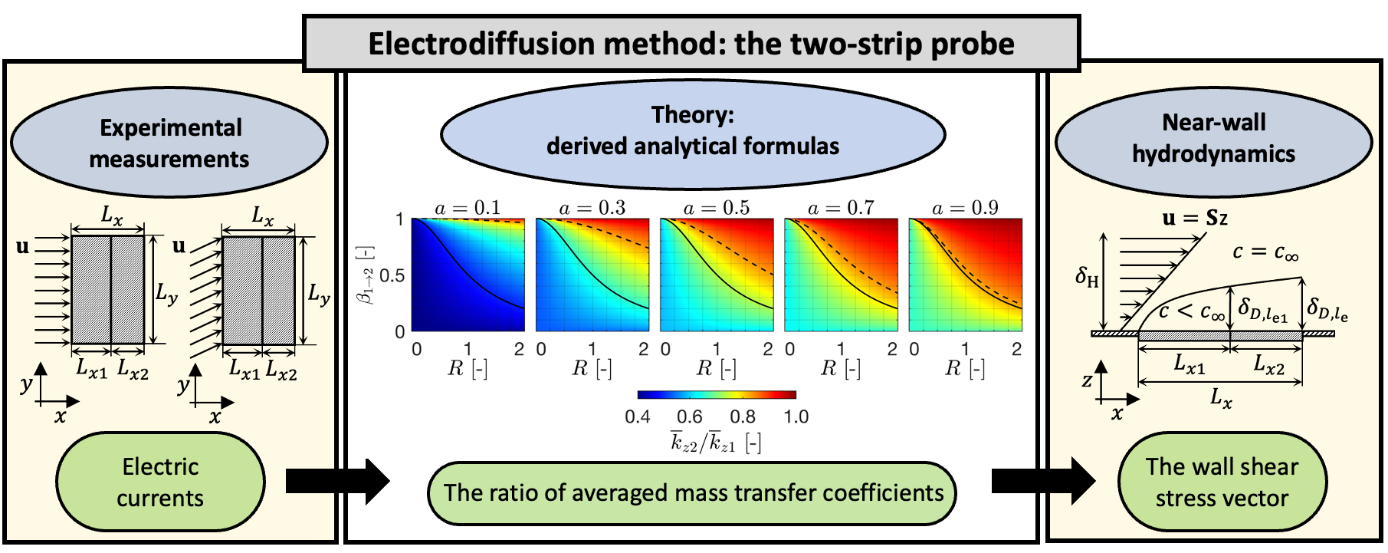Bubble and drop dynamics at microscale level
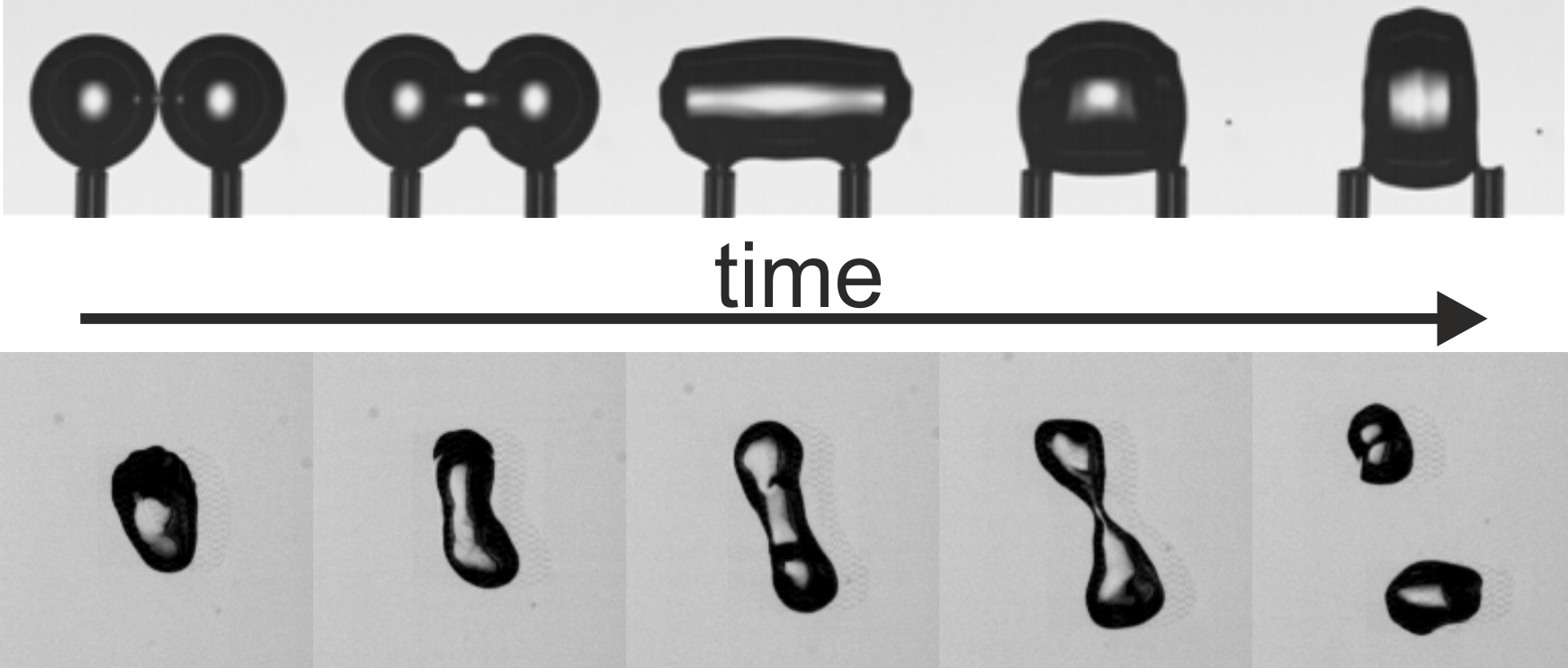 To understand the behavior of bubbly or emulsion systems, it is necessary to study the dynamics of individual bubbles or drops (particles). The interaction of two particles can lead to coalescence (joining), or when a bubble or droplet interacts with a vortex, it can break into several smaller particles. The research aims to describe the dynamic changes of bubbles or drops in different situations (e.g. formation, deformation, coalescence, breakup).
To understand the behavior of bubbly or emulsion systems, it is necessary to study the dynamics of individual bubbles or drops (particles). The interaction of two particles can lead to coalescence (joining), or when a bubble or droplet interacts with a vortex, it can break into several smaller particles. The research aims to describe the dynamic changes of bubbles or drops in different situations (e.g. formation, deformation, coalescence, breakup).
Effect of surface-active agents on the multiphase flows
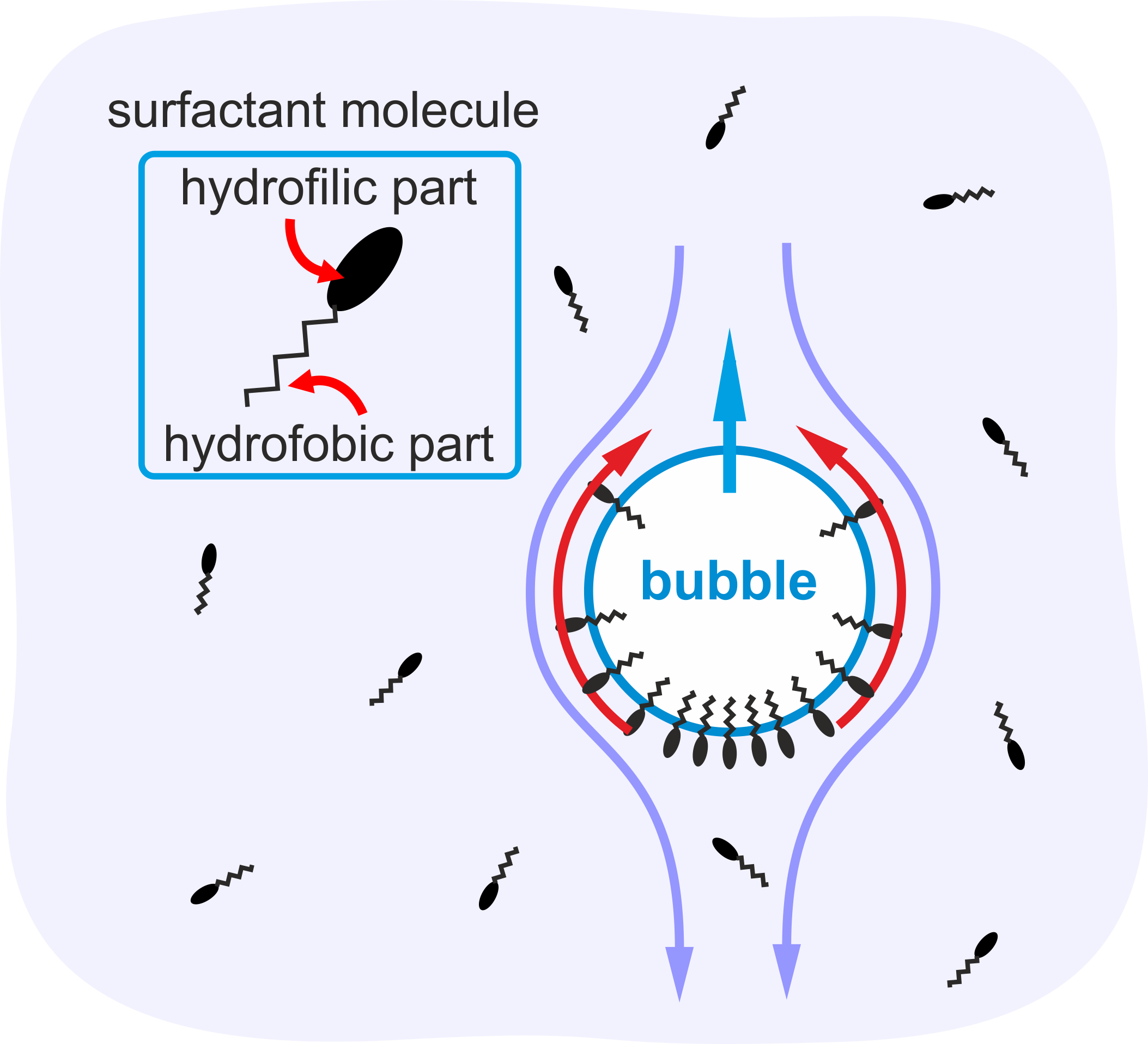 Surfactants are substances whose molecules adsorb on the interfacial surface and influence the behaviour of multiphase systems (especially gas-liquid dispersions). In the case of biosurfactants (e.g. proteins, peptides), the mechanism of adsorption to the interface is not sufficiently described, and therefore it is difficult to predict their influence on the behaviour of the entire system. The aim of the research is to study the mechanism of adsorption of surfactants and biosurfactants on the bubble interface and their projection to hydrodynamics and mass transfer in bubbly flows.
Surfactants are substances whose molecules adsorb on the interfacial surface and influence the behaviour of multiphase systems (especially gas-liquid dispersions). In the case of biosurfactants (e.g. proteins, peptides), the mechanism of adsorption to the interface is not sufficiently described, and therefore it is difficult to predict their influence on the behaviour of the entire system. The aim of the research is to study the mechanism of adsorption of surfactants and biosurfactants on the bubble interface and their projection to hydrodynamics and mass transfer in bubbly flows.
Powder and granular systems
 Powder and granular systems, characterized by a variety of particle sizes, shapes, and material properties, exhibit complex dynamic behavior. These systems are influenced by forces, the spatial arrangement of individual grains, and flow properties, which together determine macroscopic behavior such as segregation, mixing, and pattern formation. Using advanced computational models and experiments, our research aims to describe the theoretical basis for the behavior of these systems. The results of our research have potential applicability in various industries, such as pharmaceutical and chemical industries, agriculture, and construction.
Powder and granular systems, characterized by a variety of particle sizes, shapes, and material properties, exhibit complex dynamic behavior. These systems are influenced by forces, the spatial arrangement of individual grains, and flow properties, which together determine macroscopic behavior such as segregation, mixing, and pattern formation. Using advanced computational models and experiments, our research aims to describe the theoretical basis for the behavior of these systems. The results of our research have potential applicability in various industries, such as pharmaceutical and chemical industries, agriculture, and construction.
Mass transport through liquid films
Thin liquid layers are crucial for a number of important transport processes in physics, chemistry, and engineering. At the interface between gas and liquid phases, the dissolution of substances and their transport by diffusion occurs due to the different physical properties and solubility of the gases. Our goal is to develop a thin liquid film-based system for efficient separation of gaseous mixtures and to optimize it for state application. This is a novel idea with the potential to improve gas separation processes.
Other research topics
- Heat transfer in liquids with nanoparticles
- Hydrodynamics of micro and nanobubbles
Damping effect of surfactants on induced bubble shape deformations
Bubbles in liquids are part of many industrial applications. Liquids usually contain surfactants that adsorb on the surface of the bubbles and significantly influence their behavior. This work investigates the damping effect of surfactants on bubble surface deformation in two experimental situations. A high-speed camera is used to observe the controlled oscillations of the bubble and the rebound of the bubble from the solid wall. These experiments are performed in pure water and in aqueous solutions of five different surfactants. The recorded videos allow comparison of the frequencies and decay times of the induced oscillations, as well as the degree of attenuation of the rebound of the bubble from the solid wall.
It was found that the surface elasticity of the bubble plays a key role and that there is a universal relationship between the energy dissipation during bubble deformation and the surfactant concentration on its surface. The deformation damping time decreases rapidly with increasing surfactant concentration, reaches a minimum and stabilizes at a final value at high concentrations. In both cases studied, it is necessary to reach approximately the same optimum value of surface elasticity (4 mN/m) for the maximum damping of interfacial deformations. In addition, the rebound of the bubble from the wall is very sensitive to the presence of even a trace amount of surfactant.
Fig. (i) The experimental apparatus allows to study the effect of surfactants on the bubble deformation in two independent experiments: controlled oscillations of the bubble attached to the capillary and spontaneous rebound of the bubble from the wall.
(ii) Surfactant molecules adsorbed from the liquid onto the bubble surface affect the surface elasticity and thus more quickly suppress the bubble shape deformations.
Vobecká L., Orvalho S., Zedníková M., Vejražka J., Tihon J.: Damping effect of surfactants on induced bubble shape deformations. Physics of Fluids 35(12), 122120, 2023. DOI: 10.1063/5.0174954
Bubble formation and swarm dynamics: Effect of increased viscosity
Aiming to make the bridge between the studies of bubble behaviour as single bubble and in bubble columns, the characteristics of bubbles in an aerated column with a low gas content were investigated: bubbles formed at one single 0.5 mm orifice in a partially sparged small lab-scale bubble column were visualized by high-speed camera. The formation process and bubble behaviour at heights of 20 and 40 cm above the orifice were investigated. The bubble size, deformation and velocity were investigated in aqueous glycerol solutions (1 to 10 mPa.s). Average characteristics of the bubbles in swarms were obtained by statistical data processing. It was found that, the bubble formation mechanism governs the size and velocity of bubbles in swarms and that, in the investigated range, viscosity has little effect on the bubble behaviour. Individual bubbles in the swarm differ significantly in their size, shape, and velocity without correlation between these quantities.
Fig. Modes of bubble formation observed at single 0.5 mm orifice (from bottom-up): Double bubbling; Triple bubbling; Multiple coalescence with breakup; Multiple coalescence without visible breakup.
Crha, J., Orvalho, S., Ruzicka, M.C., Shirokov, V., Jerhotová, K., Pokorny, P., Basařová, P., Bubble formation and swarm dynamics: Effect of increased viscosity. Chemical Engineering Science. 119831, 2024. DOI: 10.1016/j.ces.2024.119831
Unsteady behaviour of bubble column in homogeneous flow regime: Startup and shutdown
The startup (engagement, EN) and shutdown (disengagement, DE) processes in the bubble column are investigated both experimentally and theoretically. Two horizontal interfaces, top and bottom, characterize the evolving bubble bed. Their motion is explored by measurements in a laboratory air–water bubble column operated in the homogeneous flow regime (HoR). The effect of two control parameters is determined: clear liquid height L and gas superficial velocity q. The following results are obtained: the trajectories of the top and bottom interfaces, the duration of the early and late stages of EN, the coordinate points of the typical events of the bubble bed dynamics, the bubble swarm velocities related to the interfaces, the characteristic time scales, the symmetry features of EN and DE processes, the parametric dependence on L and q. A simple mathematical model is suggested to describe and interpret the experimental data.
Fig. Evolution of liquid free surface and bubble bed during startup (engagement) and shutdown (disengagement) processes.
Ruzicka, M.C., Orvalho, S., Unsteady behaviour of bubble column in homogeneous flow regime: Startup and shutdown. Chemical Engineering Science 277, 118806, 2023. DOI: 10.1016/j.ces.2023.118806
The electrodiffusional theory for the wall shear stress measurement by two-strip probe
The wall shear stress vector is the key quantity influencing the transfer phenomena in the boundary layers. Instead of conventional measurement techniques, which often fail in the vicinity of solid surfaces, the electrodiffusion method seems to be a suitable candidate for the measurement of boundary layer hydrodynamics. However, in order to exploit its full potential, knowledge of the theory linking the measured limiting electric current to the shear velocity vector at the wall is required. The newly derived electrodiffusion theory provides a means for experimental measurements to obtain the wall shear stress vector. The measurements are performed with a two-strip probe, which, in a compact design, provides the two electrical signals necessary for a complete description of the wall shear stress vector. In addition to the development of a suitable methodology for the evaluation of the experimentally obtained data, the publication also deals with the theoretical analysis of the mass transfer in the vicinity of the measuring probe, and the optimal aspect ratios of the sub-segments are proposed in order to maximize the sensitivity of the probe to changes in the angle of the flowing fluid.
Fig. Application of the electrodiffusional method for the wall shear stress measurement by two-strip probe
Harrandt, V., Kramoliš, D., Huchet, F., Tihon, J., Havlica, J., The electrodiffusional theory for the wall shear stress measurement by two-strip probe. International Journal of Heat and Mass Transfer. 212, 124287, 2023. DOI: 10.1016/j.ijheatmasstransfer.2023.124287
Experimental and numerical study of the flux of isobutane vapors near saturation through multi-layered ceramic membranes
Capillary condensation of vapors in small pores can significantly affect the efficiency of gas separation through a porous membrane. It occurs under pressure conditions close to the saturated vapor pressure of the condensable gas. Our latest work in collaboration with Dr. Loimer from the Technical University of Vienna investigates experimentally and theoretically the transport of vapors of isobutane near saturation during permeation through multi-layered asymmetric membranes (3 to 5 layers with a pore size of 3 mm to 20 nm). The influence of the upstream state of the vapor, whether far or close to saturation, and of the orientation of the membrane on the mass flow rate was investigated. For a membrane with five layers, the mass flux increased by about 80 % for a vapor close to saturation. Also, close to saturation the mass flux in the flow direction from the separation layer to the support was up to 50 % larger than in the opposite direction. Three theoretical descriptions of the flow process were given in the work, assuming that condensation may take place, with respect to heat transfer from the surroundings.
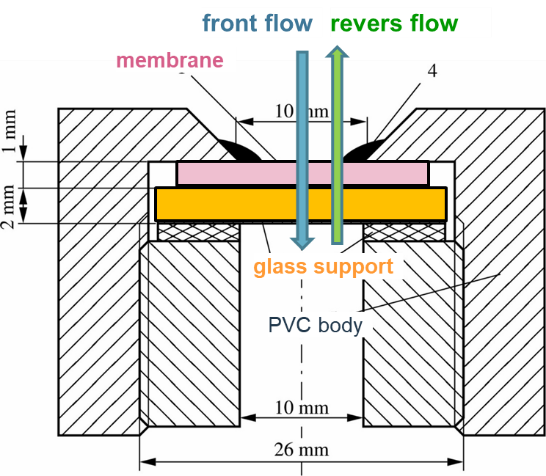 |
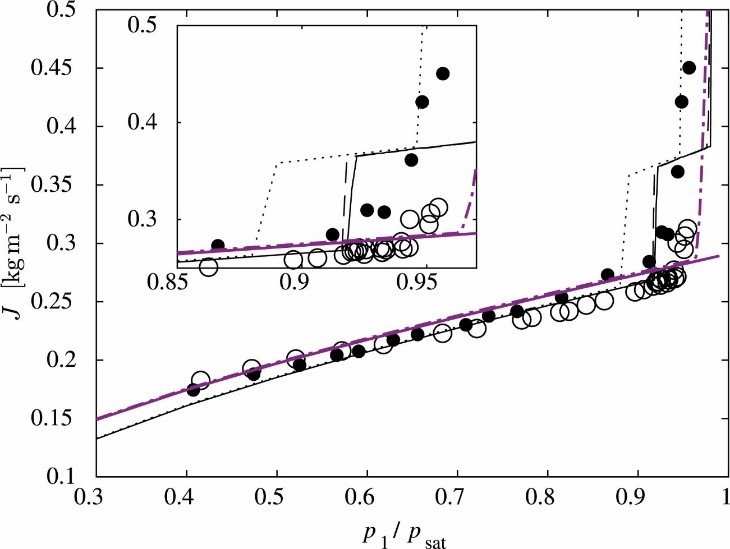 |
| Membrane holder | Experiment and theory comparison |
Setnickova K., Petrickovic R., Uchytil P., Loimer T.: Experimental and numerical study of the flux of isobutane vapors near saturation through multi-layered ceramic membranes. Separation and Purification Technology 306, 122604, 2023. DOI: 10.1016/j.seppur.2022.122604
Rheology of hydrogels and their nanocomposites
Hydrogels and their nanocomposites are materials that are widely used today, from the pharmaceutical sector (contact lenses, wound dressings, drug delivery) to the environmental sector (effective adsorbents). Although these materials have been used for several decades, their preparation is typically focused only on the ratio of reactants in the reaction mixture, regardless of the amount of water present. As part of our research, we tested the targeted control of the water content of polyacrylamide hydrogels by varying the water content during polymerization. At the same time, the morphology and strength of the hydrogel are related to the water content, so these properties can be adjusted as needed.
The influence of the structure and composition of hydrogel nanocomposites on their properties (morphology, rigidity and especially their selectivity and adsorption capacity for organic dyes) was also studied. The type of additive (graphene, k
aolin or laponite), its content and the water content in the polyacrylamide hydrogel nanocomposite were varied. It was found that the most effective way to increase the adsorption capacity for organic dyes is the addition of laponite, selectively for cationic dyes having phenyl groups in their structure. Adsorption isotherms showed that nanocomposites with medium water content (i.e. optimal pore size) were the most effective adsorbents.

Fig. The volume of the hydrogel increases with increasing water content, while the rigidity in terms of elastic and viscous moduli decreases (left). Time course of adsorption of brilliant green onto laponite nanocomposite (right).
Penkavova, A. Spalova, J. Tomas, J. Tihon, Polyacrylamide hydrogels prepared by varying water content during polymerization: Material characterization, reswelling ability, and aging resistance, Polymer Engineering & Science 62 (2022) 901-916. DOI: 10.1002/pen.25895
Penkavova, A. Spalova, J. Tihon, Polyacrylamide hydrogel-based nanocomposites containing graphene, kaolin or laponite: Physico-mechanical characterization and adsorption properties, Materials Today Communications 34 (2023) 105150. DOI: 10.1016/j. mtcomm.2022.105150
